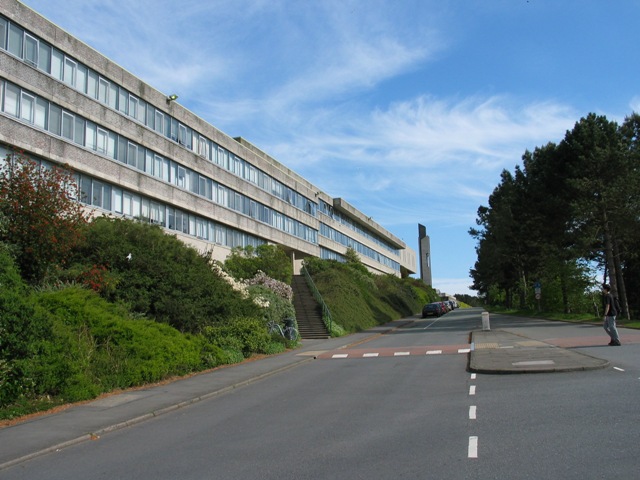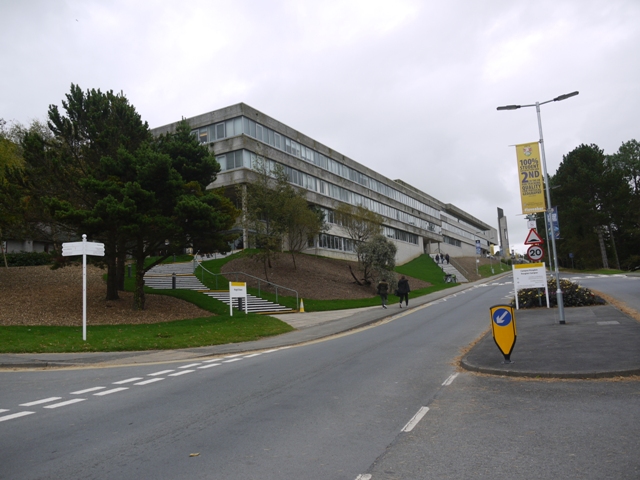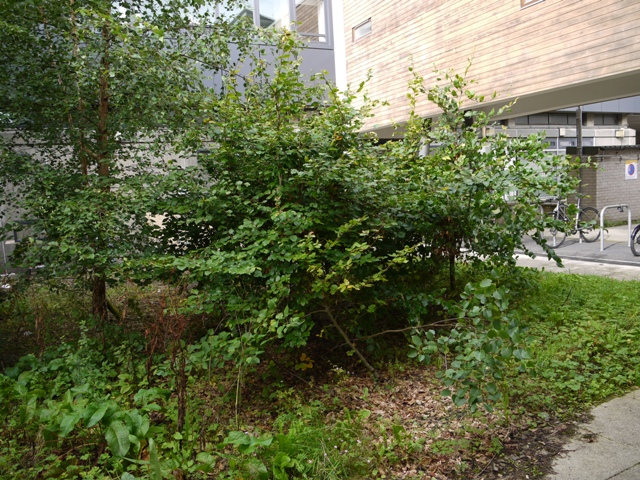by the Curious Scribbler
It seems to be a little known fact that the Penglais campus, in conjunction with the adjoining sites of the Llanbadarn campus and the National Library of Wales are listed Grade II* in the Cadw Register of Landscapes, Parks and Gardens of Special Historic Interest in Wales. This is praise indeed, this grading makes it one of the three most important gardens in Ceredigion, and one of the very few 20th century landscapes deemed of national importance. The listing was published in 2003. The inspector summarizes it thus:
The landscaping of the University of Aberystwyth campuses, particularly the earlier Penglais campus is of exceptional historic interest as one of the most important modern landscaping schemes in wales. The sophisticated layout, including the landscaping, is sensitive to the character of the site, and the planting, which is unusually choice and varied both enhances the buildings and helps to integrate the the sites. Several densely packed pages describe the grounds and their plantings in detail, and the steep bank below the Hugh Owen library gains especial praise.
It was indeed justified, and I have dug out a photo from 2003 which shows the clean lines of the modern building embraced by a swathe of shrubs, hebes, fuchsias and the ground-hugging Cotoneaster microphyllus clothing the steep banks. (The red flowered shrub was Embothrium coccineum, the Chilean Firebush, a connoisseur’s tree, frost hardy and fussy about its soil, cleverly planted by knowledgeable gardeners).

The Hugh Owen building, Penglais Campus, Aberystwyth with original planting in 2003
All gone now! Last month contract gardeners with a caterpillar digger were hard at work and today’s view is of turf, bark and a few retained trees, some of them self-seeded ash.

The Hugh Owen Building, Penglais Campus, Aberystwyth in 2017
There have been maintenance problems at the campus in the last decade, and regular visitors have noted the vigorous incursions of brambles, sycamores and ash trees, self seeded amongst the shrubs. Back in the 1990s when I sometimes visited head gardener John Corfield in his potting shed I would find up to nine gardeners, who together tended the Penglais campus and the mansion gardens and botanical order beds on the other side of the road. Today his successor, gardener Paul Evans is responsible for three campuses, Penglais, Llanbadarn and Gogerddan with a team half the size! Little wonder that the brambles got away..
Bit by bit the character of Aberystwyth’s distinctive campus is being whittled away, while new 21st century innovations have been introduced with no provision for aftercare. The new IBERS building next to the Edward Llwyd is a case in point. Its landscape architect included a green wall, a complicated beech maze and a sedum roof. The green wall died and has been cleared away, and the maze was never pruned and became an interlocking thicket of beech trees. The roof gets rare maintenance by contract gardeners, because none of the grounds staff have received training for working of roof tops.

The beech maze beside the new IBERS building on the Penglais campus
And the agenda of Biodiversity and Native Species has led to a tendency to ignore the merits of a garden which brings together beautiful non-native plants from all over the world. For some odd reason ecologists seem to assume that only native species are agreeable to bees. How wrong! Recent research at the National Botanic Garden of Wales analysing the DNA fingerprint of pollen in the pouches of honey bees showed that two of the top six favourites are the despised sycamore and the invasive Himalayan Balsam!
The 1960-1970s planting of the campus was supervised by botanists and involved the trialing of species and hybrids suited to windswept maritime situations from every continent. Many still survive in gardens around Aberystwyth. But is the campus on a trajectory to turf, bark and the utility planting of an average supermarket carpark?
And what about the street furniture? Back in 2003 it seems that students found their way around without notice boards or banners telling them how happy and lucky they were, and motorists kept left and slow without constant reminders. Certainly the elegance of the first picture is in stark contrast to the tired building in the second, grey with age but cleaner at the base where the shrubs formerly embraced it.

This is such a shame, but it’s the same all over the country. Driving around I see hedgerows and trees not looked after at all, so that for example overgrowth means that road direction signs, and even traffic lights, are not seen properly until they are almost passed. Municipal parks and gardens are also suffering the same fate. This is the result of austerity. Except that austerity has always been with us, so it is more a matter of funding priorities.
And what about the sorry state of Plas Gogerddan’s once maintained and well stocked gardens?
Dare one hope that the soon-to-be-built £27million Innovation and Enterprise Campus at Gogerddan will include a realistic budget for the maintenance of the once-fine gardens of the old Plas? Sadly, the architect’s impression looks more concerned with troughs of bedding and yet more green walls.
The original landscape design of 1963 was by the influential Brenda Colvin (1897–1981) and can be read on the Royal Commission’s website here: http://orapweb.rcahms.gov.uk/coflein//C/CPG164.pdf where it is described as “one of the most important modern landscaping schemes in Wales”.
Colvin’s design was limited to the area from Pantycelyn up to the Cledwyn Building and across to the Swimming Pool (the three oldest buildings on the campus) and is one of very few of her schemes which has survived.
It’s heartbreaking to see the change in character of of these gardens. I wonder what happened to the navy coloured hydrangea, varieties of cotoneaster, acers, blackthorn etc. And I wonder whether we will witness the erosion of the steep banks without these carefully chosen shrubs and plantings. Last year it was shocking to see plastic flowers in hanging baskets alongside dozens of dead bees.
How interesting . My dad worked in the botanical and physics departments of the uni back in 1963. I doubt I would recognise the campuses now.
I was Head Gardener at the Llanbadarn Campus in the 1990’s when we won a 1st in the Wales in Bloom competition in the ‘public utilities’ category. It was an exciting time, introducing a more environmentally friendly approach to Grounds maintenance, reducing the use of chemicals, recycling etc. Landscaping was thoughtfully carried out and seemed to be appreciated. After the merger with U.W.A.I took over from John Corfield for several years and Paul Evans , who had been promoted to my Deputy during this time, succeeded me when I took early retirement due to ill health. The merger had changed everything. More stress, less staff and a situation where the landscaped grounds featured less and less in the priorities of those in charge of the University. My staff had had training in horticulture and a graded staff structure but we were told that maintenance workers were required not horticulturalists. Chop back with no regard for the needs of the plants or overall beauty of the landscape. Carefully planned and planted new areas could be destroyed shortly afterwards by JCB’s digging trenches for more computer cables or building works. There was no joined up thinking or consideration between departments. It is so demoralising for the staff. Paul Evans is doing his best under very difficult circumstances. I feel that the campus has now lost it’s status for horticultural excellence and that things will only get worse. A sign of the times, unfortunately.
I agree with you Joy, What a mess the campus has be come. Look what they have done to my greenhouses . 40 odd years work down the drain.Basil Fox and Prof Waring must be turning in their graves.
Yes, Don, couldn’t agree more! Lilian Newton, too! So demoralising for everyone who had a vision for this wonderful campus and Plas grounds.
I had noticed all the tree and bush cutting at the Penglais Campus entrance. It’s a real shame after the good work they’d done planting wildflowers. Two steps forward, one step back. 🙁
The campus has such great potential. The greenery is important for wildlife, student satisfaction, and to counteract some of the uglier concrete buildings. Removing all the plants like this is not an improvement.
Thanks for flagging this up.
‘But is the campus on a trajectory to turf, bark and the utility planting an average supermarket carpark’ …… as the whole of Britain is soon going to be in many other areas, too — nature’s analogy to #Brexit…